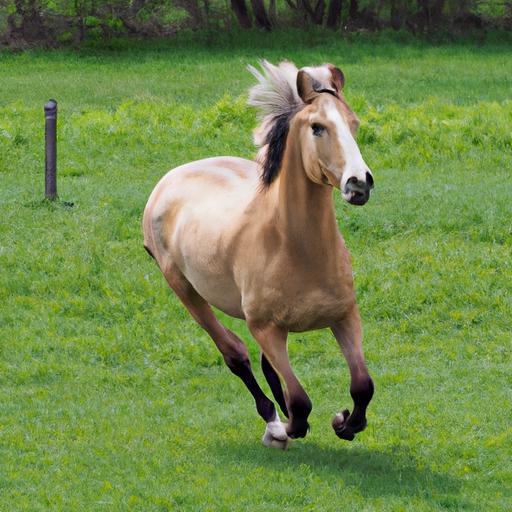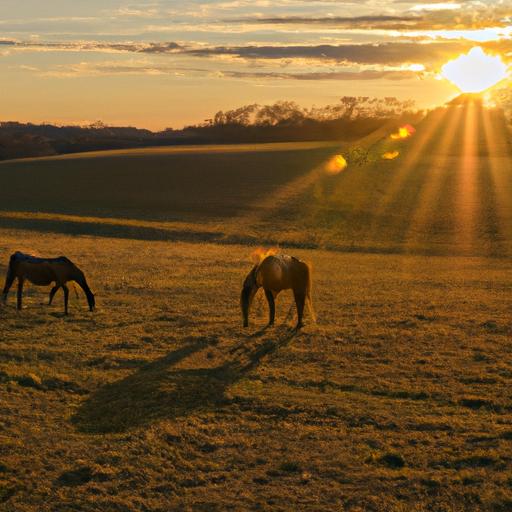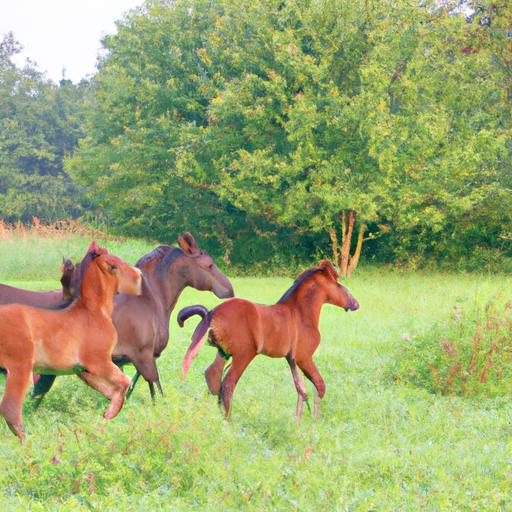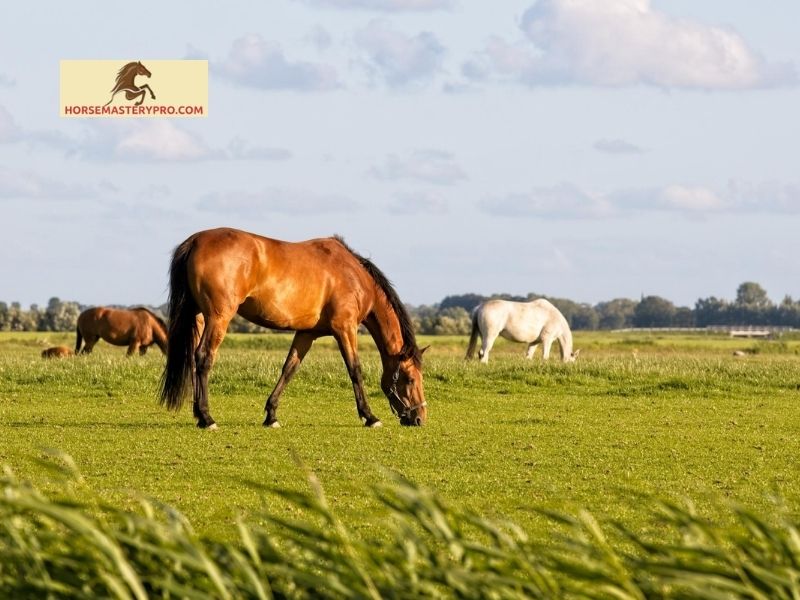Discover the key factors for optimal pasture management for horses in the pasture. Explore suitable grasses, size, layout, fencing, shelter, and water availability.
Welcome to Horse Mastery Pro! Today, let’s embark on an exciting journey to explore the enchanting world of horses in the pasture. Have you ever wondered why horses thrive in the vast expanse of green fields? Join me as we uncover the importance of horses in the pasture and gain valuable insights into their natural habitat.
As majestic creatures, horses possess an innate connection to open spaces and lush grasslands. The pasture serves as a haven where horses can roam freely, fully embracing their natural spirit. It provides them with an environment that closely mimics their wild ancestors, allowing for optimal physical and mental well-being.
In this comprehensive guide, we will delve into the various factors that contribute to the ideal pasture management for horses. By understanding the characteristics of pastures and the benefits they offer, we can create a harmonious environment that promotes the horses’ overall health and happiness. So, let’s saddle up and explore the wonders of horses in the pasture together!
Throughout this article, we will explore the types of grasses and forages that are suitable for horses, the appropriate pasture size and layout, as well as the necessary fence and shelter requirements. We will also discuss the importance of water availability in the pasture and its impact on the horses’ hydration and digestion.
Join me in the next section as we dive into the lush world of pastures and uncover the secrets to nurturing the natural spirit of horses. Together, we will discover how proper pasture management can create a sanctuary where horses can thrive, roam, and graze to their heart’s content. So, let’s continue our adventure and unlock the wonders of horses in the pasture!
Stay tuned for Section II: Understanding the Natural Habitat of Horses.
Understanding the Natural Habitat of Horses

A. Characteristics of Pastures
When it comes to creating an ideal habitat for horses, understanding the characteristics of pastures is essential. Pastures consist of various grasses and forages, offering a diverse range of nutrients and textures for horses to graze upon. These grasses may include fescue, timothy, bermudagrass, and many others, each with its unique qualities.
It is crucial to consider the type of grasses that are suitable for horses in your region. Some grasses may be more resistant to grazing pressure or better adapted to specific climates. By selecting the right grasses, you can ensure a nutritious and sustainable food source for your equine companions.
Additionally, the condition of the pasture soil plays a vital role in sustaining healthy vegetation. Conducting regular soil testing allows you to understand its pH levels, nutrient composition, and potential deficiencies. This knowledge empowers you to make informed decisions regarding fertilization and soil amendment, ensuring the optimal growth and quality of the grasses.
B. Benefits of Pasture Grazing for Horses
Pasture grazing offers numerous benefits for horses, both physically and mentally. The natural habitat of the pasture allows horses to engage in constant movement, promoting healthy weight management and muscular development. The expansive space encourages regular exercise, leading to improved cardiovascular fitness and overall agility.
Moreover, the act of grazing itself is vital for the horse’s digestive system. Horses are natural grazers, designed to consume forage throughout the day. The continuous access to fresh grasses stimulates saliva production, aiding in the breakdown of food and preventing digestive issues such as colic.
Beyond the physical advantages, pasture grazing also contributes to the horses’ mental well-being. The freedom to roam and socialize with other horses fosters a sense of companionship and contentment. Horses are social animals, and the pasture environment allows them to engage in natural herd dynamics, reducing stress and promoting a more balanced temperament.
In the next section, we will explore the essential factors to consider for optimal pasture management. From grass selection to proper layout, we will dive deep into the aspects that ensure a thriving and vibrant pasture for our beloved equines. So, let’s continue our exploration of horses in the pasture and unlock the secrets to nurturing their natural spirit!
Stay tuned for Section III: Factors to Consider for Optimal Pasture Management.
Section III: Factors to Consider for Optimal Pasture Management

To ensure the well-being and vitality of horses in the pasture, it is crucial to consider various factors that contribute to optimal pasture management. By paying attention to these key elements, we can create a nurturing environment that supports the horses’ physical health and overall happiness.
A. Types of Grasses and Forages Suitable for Horses
Selecting the right types of grasses and forages is paramount in providing a nutritious grazing experience for horses. Species such as Timothy, Orchardgrass, and Kentucky Bluegrass are commonly favored by equines due to their palatability and nutritional value. Additionally, incorporating legumes like alfalfa or clover into the pasture can add essential protein and minerals to the horses’ diet.
B. Pasture Size and Layout
The size and layout of the pasture play a significant role in promoting the horses’ well-being. A well-designed pasture allows for ample space for horses to roam and engage in natural behaviors. The size of the pasture should be determined by the number of horses and their individual needs. Proper fencing and adequate pasture divisions can help facilitate rotational grazing and prevent overgrazing in specific areas.
C. Fence and Shelter Requirements
Ensuring the safety and security of horses in the pasture is paramount. Sturdy and properly maintained fencing is essential to prevent escapes and protect the horses from external threats. Additionally, providing adequate shelter, such as run-in sheds or stables, allows horses to seek protection from inclement weather conditions and provides a comfortable resting area.
D. Water Availability in the Pasture
Access to clean and fresh water is vital for horses’ overall health and hydration. Ideally, there should be a reliable water source within the pasture, such as troughs or natural streams, ensuring that horses can stay properly hydrated throughout the day. Regularly inspecting and cleaning water sources is essential to prevent contamination and ensure a continuous supply.
By considering these factors, we can create an optimal pasture environment that supports the horses’ natural behaviors, nutritional needs, and overall well-being. Join me in the next section as we explore the best practices for pasture maintenance, ensuring a thriving and vibrant pasture for our equine friends.
Stay tuned for Section IV: Best Practices for Pasture Maintenance.
Health and Safety Considerations for Horses in the Pasture

As we continue our exploration of horses in the pasture, it is crucial to prioritize the health and safety of these magnificent creatures. Just like any other living being, horses are susceptible to various risks and hazards. In this section, we will delve into the essential considerations for maintaining the well-being of our equine companions in the pasture.
A. Parasite Control and Deworming
Parasites can pose a significant threat to the health and vitality of horses. Regular deworming protocols are essential to prevent infestations and maintain optimal health. Consult with your veterinarian to develop a deworming schedule tailored to your horse’s specific needs. By implementing a strategic parasite control program, we can safeguard our horses from the detrimental effects of internal parasites.
B. Monitoring for Toxic Plants
Pastures may harbor toxic plants that can be harmful or even fatal to horses if ingested. It is crucial to familiarize yourself with the common toxic plants in your area and regularly inspect the pasture for their presence. Remove any hazardous plants promptly to prevent accidental ingestion. Remember, prevention is key when it comes to protecting our equine friends from the dangers of toxic vegetation.
C. Preventing Injuries and Accidents
Safety should always be a top priority when managing horses in the pasture. Regularly inspect the fencing to ensure it is secure and free from any sharp edges or protrusions that may cause injuries. Additionally, remove any debris or potential hazards from the pasture, such as large rocks or branches. Maintaining a safe environment plays a vital role in minimizing the risk of accidents and injuries.
D. Providing Adequate Veterinary Care
Regular veterinary care is essential for maintaining the overall health and well-being of horses in the pasture. Schedule routine check-ups, vaccinations, and dental examinations to address any potential health issues promptly. Regular hoof care, including trimming and farrier visits, is also crucial for ensuring soundness and preventing lameness. By providing comprehensive veterinary care, we can ensure that our horses thrive in the pasture.
Stay tuned for the next section where we will conclude our journey through the world of horses in the pasture. Together, we will summarize the importance of proper pasture management and reflect on the wonders that await our equine companions in these natural havens of freedom.
Continue to Section VI: Conclusion.
Conclusion
As we conclude our exploration of horses in the pasture, it becomes evident that nurturing their natural spirit in the right environment is paramount. By understanding the importance of horses in the pasture and implementing proper pasture management techniques, we can create a haven where these magnificent creatures can thrive and flourish.
Throughout this journey, we have delved into the factors that contribute to optimal pasture management. We learned about the types of grasses and forages suitable for horses, the significance of pasture size and layout, and the necessity of providing appropriate fence and shelter requirements. Moreover, we explored the crucial role of water availability in the pasture, ensuring the horses’ hydration and overall well-being.
At Horse Mastery Pro, we believe that horses in the pasture embody the true essence of freedom and connection with nature. It is our mission to empower horse enthusiasts like you to provide the best possible environment for these remarkable animals. By implementing the practices we’ve discussed, you can create a safe and nurturing pasture that supports the horses’ physical and mental health.
If you’re ready to take your journey with horses to the next level, visit horsemasterypro.com. Our team of experts is dedicated to providing valuable resources, training programs, and personalized guidance to help you become a master in horsemanship. Together, let’s continue to foster a deep bond between horses and humans, ensuring their well-being and happiness in the pasture and beyond.
Remember, the pasture is not just a home for horses; it is a sanctuary where they can truly thrive. Let’s embrace this connection with nature and create a haven that allows horses to roam, graze, and be in harmony with their natural instincts. Thank you for joining us on this remarkable journey, and we look forward to supporting you on your horsemanship endeavors.
Stay tuned for more exciting content and resources from Horse Mastery Pro!


